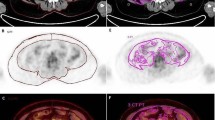Abstract
Purpose
To determine the relationship between metabolic activity of adipose tissue on FDG PET/CT and prognosis in colorectal cancer.
Methods
A total of 176 colorectal cancer patients with curative surgical resection were retrospectively enrolled. Volume and metabolic activity of subcutaneous adipose tissue (SAT) and visceral adipose tissue (VAT) on FDG PET/CT images were measured. The maximum standardized uptake value (SUV) of primary tumor (SUVtumor) was also obtained. Univariate analysis with log-rank test and multivariate Cox regression analyses were used to evaluate prognostic values of volume and metabolic activity of SAT and VAT as well as SUVtumor and clinicopathologic factors.
Results
Of 176 patients, 26 experienced recurrence during follow-up. SUVtumor showed significant correlation with serum C-reactive protein level (r = 0.242, p = 0.001), SUV of VAT (r = 0.167, p = 0.026), and size of primary tumor (r = 0.341, p < 0.001). In univariate analysis with log-rank test, SUV of VAT (p = 0.009) and SAT (p = 0.006), volume of VAT (p = 0.015), N stage (p < 0.001), M stage (p < 0.001), tumor involvement of resection margin (p = 0.001), and lymphatic invasion (p = 0.024) were significantly associated with recurrence-free survival (RFS). However, SUVtumor showed no significant association with RFS. In multivariate Cox regression analysis, SUV of VAT (p = 0.016), presence of lymph node metastasis (p < 0.001), and tumor involvement of resection margin (p = 0.011) were independent prognostic factors for RFS.
Conclusions
The SUV of VAT in patients with colorectal cancer is significantly associated with FDG uptake of primary tumor. It is an independent predictor for RFS.


Similar content being viewed by others
References
Caan BJ, Meyerhardt JA, Kroenke CH, et al. (2017) Explaining the obesity paradox: the association between body composition and colorectal cancer survival (C-SCANS study). Cancer Epidemiol Biomark Prev . https://doi.org/10.1158/1055-9965.epi-17-0200
Clark W, Siegel EM, Chen YA, et al. (2013) Quantitative measures of visceral adiposity and body mass index in predicting rectal cancer outcomes after neoadjuvant chemoradiation. J Am Coll Surg 216(6):1070–1081. https://doi.org/10.1016/j.jamcollsurg.2013.01.007
Genkinger JM, Kitahara CM, Bernstein L, et al. (2015) Central adiposity, obesity during early adulthood, and pancreatic cancer mortality in a pooled analysis of cohort studies. Ann Oncol 26(11):2257–2266. https://doi.org/10.1093/annonc/mdv355
Guiu B, Petit JM, Bonnetain F, et al. (2010) Visceral fat area is an independent predictive biomarker of outcome after first-line bevacizumab-based treatment in metastatic colorectal cancer. Gut 59(3):341–347. https://doi.org/10.1136/gut.2009.188946
Kang J, Baek SE, Kim T, et al. (2012) Impact of fat obesity on laparoscopic total mesorectal excision: more reliable indicator than body mass index. Int J Colorectal Dis 27(4):497–505. https://doi.org/10.1007/s00384-011-1333-2
Kaneko G, Miyajima A, Yuge K, et al. (2015) Visceral obesity is associated with better recurrence-free survival after curative surgery for Japanese patients with localized clear cell renal cell carcinoma. Jpn J Clin Oncol 45(2):210–216. https://doi.org/10.1093/jjco/hyu193
Lee CS, Murphy DJ, McMahon C, et al. (2015) Visceral adiposity is a risk factor for poor prognosis in colorectal cancer patients receiving adjuvant chemotherapy. J Gastrointest Cancer 46(3):243–250. https://doi.org/10.1007/s12029-015-9709-0
Yamamoto N, Fujii S, Sato T, et al. (2012) Impact of body mass index and visceral adiposity on outcomes in colorectal cancer. Asia-Pacific J Clin Oncol 8(4):337–345
Petersen RK, Hess S, Alavi A, Hoilund-Carlsen PF (2014) Clinical impact of FDG-PET/CT on colorectal cancer staging and treatment strategy. Am Jo Nucl Med Mol Imaging 4(5):471–482
Ozis SE, Soydal C, Akyol C, et al. (2014) The role of 18F-fluorodeoxyglucose positron emission tomography/computed tomography in the primary staging of rectal cancer. World J Surg Oncol 12:26. https://doi.org/10.1186/1477-7819-12-26
Lee JE, Kim SW, Kim JS, et al. (2012) Prognostic value of 18-fluorodeoxyglucose positron emission tomography-computed tomography in resectable colorectal cancer. World J Gastroenterol 18(36):5072–5077. https://doi.org/10.3748/wjg.v18.i36.5072
Byun BH, Moon SM, Shin US, et al. (2014) Prognostic value of 18F-FDG uptake by regional lymph nodes on pretreatment PET/CT in patients with resectable colorectal cancer. Eur J Nucl Med Mol Imaging 41(12):2203–2211. https://doi.org/10.1007/s00259-014-2840-5
Van de Wiele C, Van Vlaenderen M, D’Hulst L, et al. (2017) Metabolic and morphological measurements of subcutaneous and visceral fat and their relationship with disease stage and overall survival in newly diagnosed pancreatic adenocarcinoma: metabolic and morphological fat measurements in pancreatic adenocarcinoma. Eur J Nucl Med Mol Imaging 44(1):110–116. https://doi.org/10.1007/s00259-016-3525-z
Rickles AS, Iannuzzi JC, Mironov O, et al. (2013) Visceral obesity and colorectal cancer: are we missing the boat with BMI? J Gastrointest Surg 17(1):133–143. https://doi.org/10.1007/s11605-012-2045-9
Kwon HW, Lee SM, Lee JW, et al. (2017) Association between volume and glucose metabolism of abdominal adipose tissue in healthy population. Obes Res Clin Pract . https://doi.org/10.1016/j.orcp.2016.12.007
Tahara N, Yamagishi S, Kodama N, et al. (2015) Clinical and biochemical factors associated with area and metabolic activity in the visceral and subcutaneous adipose tissues by FDG-PET/CT. J Clin Endocrinol Metabol 100(5):E739–E747. https://doi.org/10.1210/jc.2014-3896
Oliveira AL, Azevedo DC, Bredella MA, Stanley TL, Torriani M (2015) Visceral and subcutaneous adipose tissue FDG uptake by PET/CT in metabolically healthy obese subjects. Obesity 23(2):286–289. https://doi.org/10.1002/oby.20957
Yoon HJ, Kim BS, Lee KE, et al. (2017) Glucose metabolism of visceral adipose tissue measured by 18F-FDG PET/CT is related to the presence of colonic adenoma. Medicine 96(25):e7156. https://doi.org/10.1097/md.0000000000007156
Pahk K, Rhee S, Kim S, Choe JG (2016) Predictive role of functional visceral fat activity assessed by preoperative F-18 FDG PET/CT for regional lymph node or distant metastasis in patients with colorectal cancer. PLoS ONE 11(2):e0148776. https://doi.org/10.1371/journal.pone.0148776
Riondino S, Roselli M, Palmirotta R, et al. (2014) Obesity and colorectal cancer: role of adipokines in tumor initiation and progression. World J Gastroenterol 20(18):5177–5190. https://doi.org/10.3748/wjg.v20.i18.5177
Harada K, Baba Y, Ishimoto T, et al. (2015) Low visceral fat content is associated with poor prognosis in a database of 507 upper gastrointestinal cancers. Ann Surg Oncol 22(12):3946–3953. https://doi.org/10.1245/s10434-015-4432-4
Park SW, Lee HL, Doo EY, et al. (2015) Visceral obesity predicts fewer lymph node metastases and better overall survival in colon cancer. J Gastrointest Surg 19(8):1513–1521. https://doi.org/10.1007/s11605-015-2834-z
Lee JW, Lee MS, Chung IK, et al. (2017) Clinical implication of FDG uptake of bone marrow on PET/CT in gastric cancer patients with surgical resection. World J Gastroenterol 23(13):2385–2395. https://doi.org/10.3748/wjg.v23.i13.2385
Kubota R, Yamada S, Kubota K, et al. (1992) Intratumoral distribution of fluorine-18-fluorodeoxyglucose in vivo: high accumulation in macrophages and granulation tissues studied by microautoradiography. J Nucl Med 33(11):1972–1980
Brown RS, Leung JY, Fisher SJ, et al. (1995) Intratumoral distribution of tritiated fluorodeoxyglucose in breast carcinoma: I. Are inflammatory cells important? J Nucl Med 36(10):1854–1861
Nahmias C, Wahl LM (2008) Reproducibility of standardized uptake value measurements determined by 18F-FDG PET in malignant tumors. J Nucl Med 49(11):1804–1808. https://doi.org/10.2967/jnumed.108.054239
Author information
Authors and Affiliations
Corresponding author
Ethics declarations
Funding
This work was supported by the Soonchunhyang University Research Fund.
Conflict of interest
The authors declare that they have no conflict of interest.
Ethical approval
All procedures performed in studies involving human participants were in accordance with the ethical standards of the institutional and/or national research committee and with the 1964 Helsinki declaration and its later amendments or comparable ethical standards. For this type of study formal consent is not required.
Rights and permissions
About this article
Cite this article
Yoo, I.D., Lee, S.M., Lee, J.W. et al. Usefulness of metabolic activity of adipose tissue in FDG PET/CT of colorectal cancer. Abdom Radiol 43, 2052–2059 (2018). https://doi.org/10.1007/s00261-017-1418-7
Published:
Issue Date:
DOI: https://doi.org/10.1007/s00261-017-1418-7




